Abstract
Background:
Clinical education is a critical and complex component of nursing education that is influenced by many variables. One of them is stress, which may disturb students’ learning, too. Stressors may differ according to the learning situation and environment, and recognizing them, seems to be essential for corrective interventions. The present work was performed to identify stressors in clinical nursing education in Iran, according to the published research reports.
Materials and Methods:
In this systematic review, all published research reports available in Iranian and International web-based data bases and search engines were searched. Also, the archives of peer reviewed Iranian nursing and medical education journals (published between 1989 and 2009) were hand searched. Out of 1104 retrieved records (by a more general terms of clinical education AND Nursing), after stepwise screening, 15 original research articles were selected for content analysis. Coded data were classified and their frequency was represented in Tables.
Results:
The following themes were obtained to classify main areas of importance for factors related to stress in clinical nursing education: a) clinical competence and ability to play one’s roles, b) care load, or stress due to care, c) main area of education, d) interpersonal relationships and interactions, e) clinical environment (facilities and equipments, space, learning opportunities, etc,…). Subthemes were also identified in each theme.
Conclusion:
Published studies in Iran provide appropriate background evidences for planning and evaluating interventional programs to reduce stress among nursing students and instructors. Each identified theme in this study could be considered as a subject for planned interventions. Among them, it seems that interpersonal relationships and interactions is of the highest priority.
Keywords: Clinical education, Iran, stress, stressor, systematic review
INTRODUCTION
Clinical education is a critical part of nursing curriculum, as more than half of the school time is spent on it, and both the clinical competencies and professional identity of the future nurses are formed in this period.[1–3] Many factors may affect clinical learning, which may be related to the learner, teacher, or the environment.[4,5] One of the important and frequently reported factors that may influence students’ learning, especially in clinical settings, is stress.[6]
Stress is defined as “The pattern of specific and nonspecific responses an organism makes to stimulus events that disturb its equilibrium and tax or exceed its ability to cope”.[7] Learning and personal change is considered as a stressor per se, but nursing education could be more stressful to learners, as it is blended with technical tasks, professional skills, human relationships, and sympathy feelings. Therefore, identifying additional stressors in the clinical context is very crucial for providing measures to minimize students’ stress to a tolerable level and helping them to cope better.[8,9]
There is considerable number of reports on stressors in clinical nursing education; naming student assessments, instructor’s teaching skills, not cooperating staff, inappropriate communication between instructors and students, as main stressors.[4,10–15] But it seems that perceived stress and related stressors may be different in different cultural context and organizational settings. In Taiwan, Tsai reported that educational protocols, especial situation of nursing, evaluation, and time management were the most important stressors.[16] All of these themes are context-bond, and may differ by changing in environment and local rules. However, another study performed in five countries, emphasized on the common stress perception among nursing students, in spite of the influence of their different cultural backgrounds.[9]
It seemed most probable that the stressors in clinical nursing education in Iranian nursing schools to be of different order from other contexts. Investigating the published literature, we found that there may be considerable reports of original researches exploring these stressors. So, we decided to perform a systematic review to gather all published reports and provide an evidence base about stressors in clinical nursing education in Iran. The main review question was: What are the factors related to stress in clinical nursing education in Iranian nursing schools?
The prepared evidence base about stress sources in clinical education could help nursing schools to have better management of stressors, and recognizing coping strategies as an integral part of teaching -learning process.[16,17] This may result in more competent nursing graduates with better mental health status.
MATERIALS AND METHODS
This is a systematic review. The main review question was “what factors have been recognized to be related to stress in the settings of clinical nursing education in Iran?”
Inclusion and exclusion criteria: All papers about clinical Nursing education, which were published from 1989 to 2009, which resulted from original research (irrespective of the research design), were entered in the study. In this step a much broader area of clinical education was looked for. Then, studies which were not related to stress factors and those whose full text was not available were excluded [Figure 1].
Figure 1.
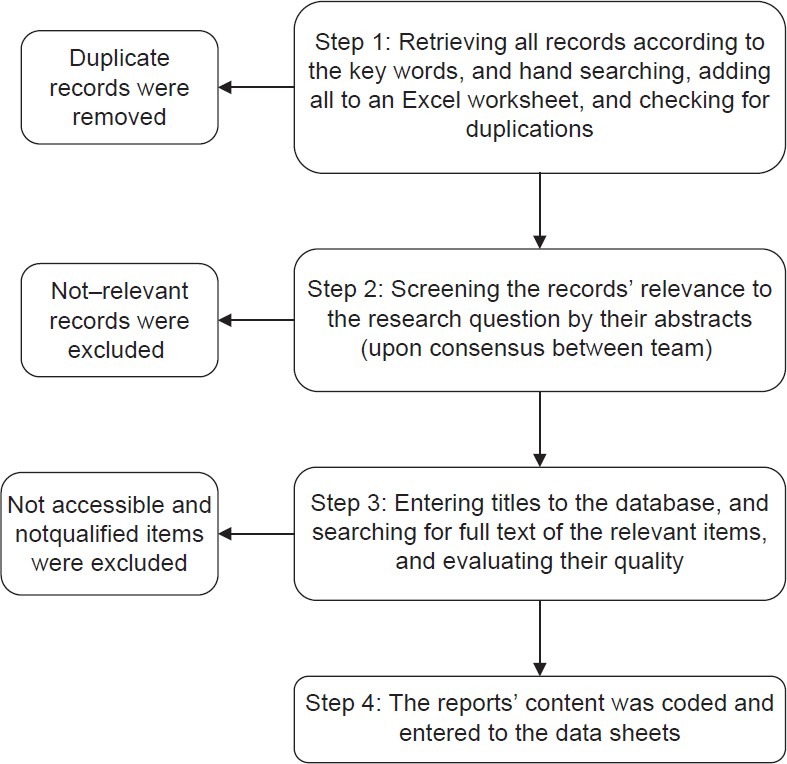
The process of screening and selection of documents for review
Searching methods and search strategy
Both electronic and hand searching was performed:
Electronic searching: All Iranian research databases (including IranMedex, Magiran, Irandoc and SID) and the most popular international databases (PubMed, Google Scholar and ERIC) were searched using appropriate key words [Table 1]. Also, the whole electronic archive of 14 Persian peer reviewed scientific journals about nursing, as well as 3 English- language Iranian journals about either nursing or medical education was searched according to the mentioned key words.
Hand searching: Since there were peer reviewed nursing or medical sciences journals in Iran which have not been completely indexed in E-data bases, their back issues was searched manually, too. Therefore, the archives of 39 journals were searched.
Table 1.
Search strategy for extraction of research reports on clinical nursing education in Iran, as the broader concept
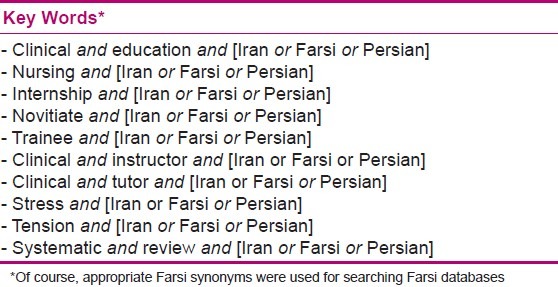
Data management and processing
All retrieved records that entered the step 2 of the screening process [Figure 1], were entered to an Excel data sheet. The next processing of documents (including examination of their relevance to the research question, the quality of the report, and the extracted codes from each report) was recorded in that sheet.
To evaluate the quality of reports, a scaled checklist was used [Table 2]. According to the scale, the range of scores for each document might be zero to 10. Each document was scored by two independent researchers, and in controversial cases, the third rater came in. The final score of document was defined upon agreement of at least two raters. Documents that scored as 5 or more were used for further analysis.
Table 2.
The scale used for evaluation of the quality of documents
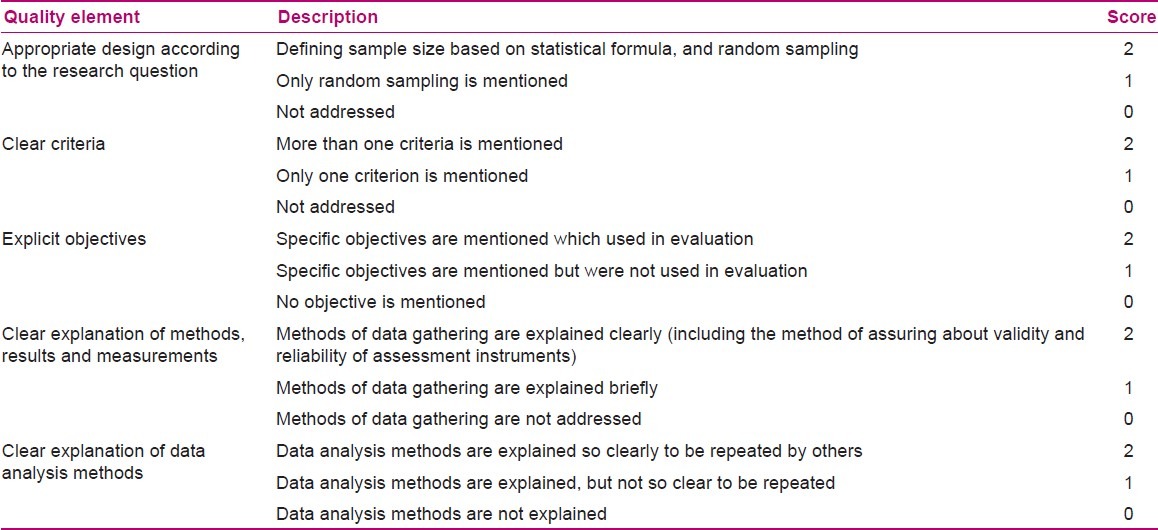
Content analysis of selected documents was done by one of the researchers in team, through determining main codes in each paper, finding themes, and classification of themes. The data rigor was achieved via double checking of the process by two other researchers in the team.
RESULTS
Retrieved documents
At the first step of electronic searching, 1066 records were retrieved related to the general subject of “clinical nursing education”. Also, 38 more records found by hand searching. Then, the title and authors of retrieved records were sorted and checked for duplications twice, in Excel sheet. After omitting the repetitive items, 424 records remained. After going through the second and third steps of screening [Figure 1], 15 documents remained which were relevant to the research question (specific subject of “stress and clinical nursing education”), and their full texts were accessed (either electronically or in hard copy). Unfortunately, the titles of grey documents (dissertations and unpublished research reports) although retrieved in the searching phase, were not accessible in spite of great effort from researchers. Conference proceedings in Iran only included abstracts, which were not so informative to be analyzed. The specifications of the 15 analyzed papers, published between 1998-2010, are presented in [Table 3].
Table 3.
General specifications of papers finally analyzed to find factors related to stress in clinical nursing education

The frequency distribution of papers according to the place of research is depicted in Figure 2. As observed, there is an acceptable distribution of researches from different places throughout the country, so that they give a good picture of the whole.
Figure 2.
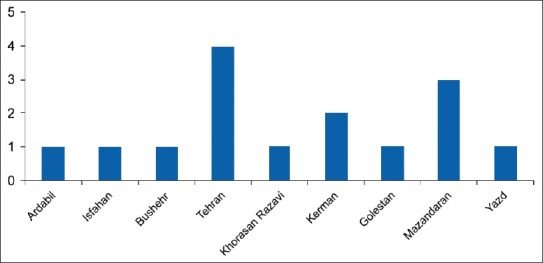
Distribution of number of papers according to the place of study (province)
Evaluation of papers, according to the indices mentioned in Table 2, showed that all papers had passed the minimum required score (5 out of 10). Therefore, all 15 papers were eligible for content analysis. The distribution of scores is represented in Figure 3. As the Figure shows, the quality score of papers has been improved in the recent years.
Figure 3.
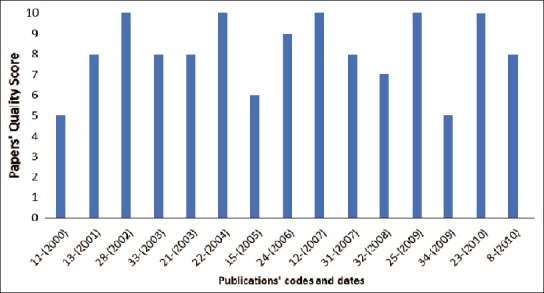
Evaluation scores of 15 papers entered in content analysis in the review
Stressors in clinical nursing education, according to the instructors
Two papers had reported stressors from the instructors’ point of view.[11,13] Summarizing the items, 4 main themes were found as the stress roots: 1) factors related to educational programming; 2) factors related to educational environment; 3) instructor’s competencies and responsibilities; 4) student-related factors. Description of factors under each theme is given in [Table 4].
Table 4.
Stressors in clinical nursing education, according to the instructors
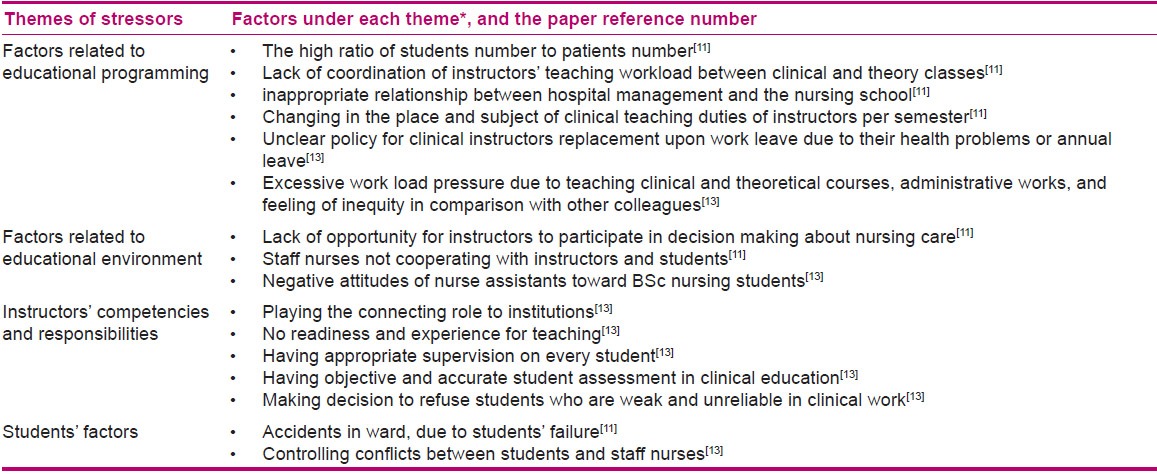
Stressors in clinical nursing education, according to the students
Since more papers were dealing with stressors according to students’ view points, all mentioned items in these papers were extracted and discussed in the review team, trying to classify items according to their nature to build more abstract and understandable themes. For example, if items “working with critically ill patients” and “observing critically ill patients suffering and pain” were mentioned in a paper as two items, a more general item “giving care to critically ill patients and observing their suffer” was formed. Detail of themes and the frequency of items under each theme are represented in [Table 5].
Table 5.
Stressors in clinical nursing education according to the nursing students: Detail of themes and the frequency of items under each theme
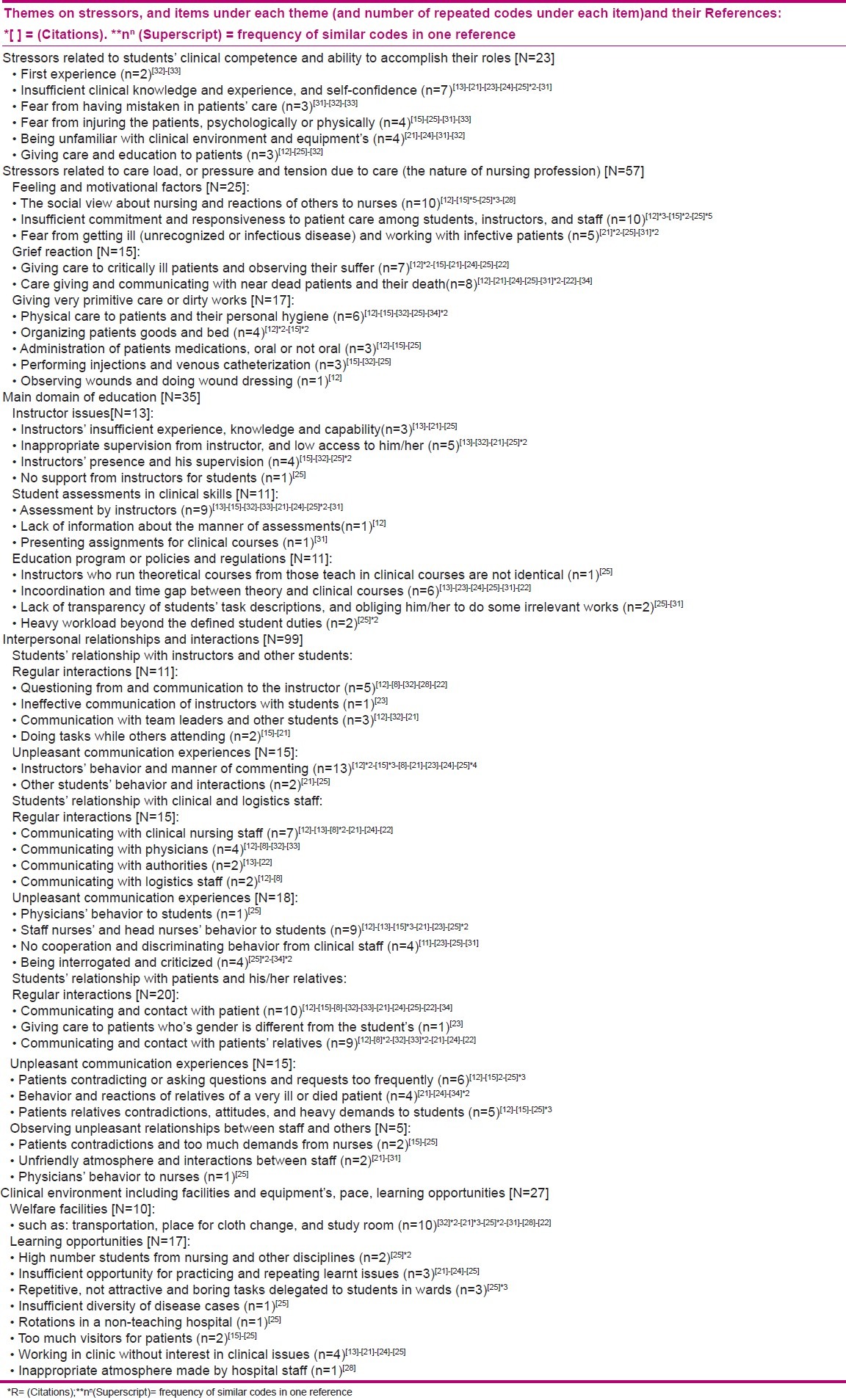
Summarizing the frequency of reported factors in Table 5, the most frequently reported stressors in clinical nursing education are as follows: Factors related to interpersonal relationships and interactions (as 41% of all reported issues) and factors related to the nature of nursing profession (as 24% of all reported issues), then, main domain of education (15%), clinical environment (11%), and finally, factors related to the students’ clinical competence and ability to accomplish their roles (9%). This is shown in Figure 4.
Figure 4.
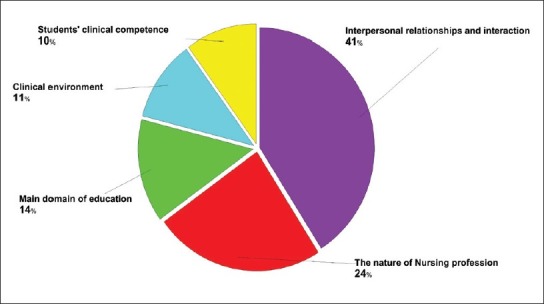
Relative frequency of themes (sources of stress) according to students’ opinions in the reviewed documents
DISCUSSION
There is great emphasis on the influence of stressor on clinical nursing education, and the number of published original researches in this field in English language literature seems to be considerable. However, we could not find any systematic review on this topic, so the present work could be considered as the first one at least in Iran.
We followed the thematic analysis, as well as quantitative summarizing of the stressors in clinical nursing education, hoping to provide a practical summary to be used as an evidence for prioritization of corrective interventions. Also, depicted figure of previous research could help investigators locate the important gaps of knowledge for further research.
It is found that most published reports (13 out of 15), are based on descriptive research design. The importance of descriptive studies in providing background information on the present situation could not be denied. However, researchers are expected to use the background knowledge to synthesize related hypotheses and test them through interventional studies. The results of the present work may help them to find suitable points for intervention.
The geographical distribution of studies reviewed in this paper includes samples from north, center, and south of Iran [Figure 2]. According to the cultural and organizational diversity in different parts of Iran, this geographical broadness ensures that the findings of this review can be generalized.
Instructors play an important role in stressor recognition and control, both for themselves and students, so that without their effective partnership in stress reduction, students will not attain a good situation for effective clinical experience and learning. Two studies in the review showed that according to instructors, stressors related to educational programming have the highest importance in imposing stress in clinical education. The next important stressor was factors related to the instructors’ competencies and responsibilities. Similar statements also have been reported in other countries.[18,19] Therefore, correcting the present programming processes, especially with instructors’ partnership, as well as empowering them, may attenuate their stress. Also, mentorship programs employing more expert instructors to help juniors, and running workshops on stress management have been reported to be effective interventions for instructors that may also result in better situation for students, too.[18,20]
The most frequently reported stressors in the reviewed literature belong to the “interpersonal relationships and interactions”, according to students. This finding brings an important message for curriculum planners and educational managers in nursing schools. They should consider effective measures to improve the present communication status in wards. These measures could include providing training courses or workshops on communication skills for both instructors and students as a curricular or extracurricular activity. This solution has been addressed in many studies,[8,15,21–23] and its effectiveness should be further tested. Also, better supervision of educational management on clinical environment, to find problems and improve human relationships between students, instructors, and non-academic staff is essential. Providing a supportive counseling system for students and instructors also may be an effective measure to decrease stress due to interpersonal conflicts. All of these interventions may be tested in experimental or at least action research studies, to clarify their real value in stress reduction and students’ development.
The second important domain of stressors was the “nature of nursing profession” as a hard profession responsible for giving critical and diverse health services to critical clients. It may be suggested that objectives regarding professional issues (values, rights and responsibilities, ethics, …) be included in the curriculum of nursing. Attaining to these objectives should be ensured so that students clearly know their future career and get ready to cope with this sort of stressors. On the other hand, efforts to make society better acknowledge and respect nursing will improve students’ attitude toward their future career and hence, decrease their stress.
As Table 5 shows, a considerable source of stress comes from inappropriate educational planning by nursing schools. Here, the important role of instructors has been emphasized. Besides the previously mentioned strategies, having clear and effective program for selecting instructor from knowledgeable and ethically committed nursing experts has a unique place. Along this, nursing schools should explore the causes of theory-practice gap in their context, clearly conceptualize clinical student assessments, and define their tasks and responsibilities in advance.[13,24–26]
Problems in clinical environment have been addressed as sources of stress in 11% of the reviewed studies. According to the institutional diversity in the studies’ context, special shortcomings in some of them, including having enough teaching hospitals, student admission policies, and financial resources for clinical education could bring some pressure to students. Although, this source is not consistent in all studies, but there should be attention to decrease its effect if it is found to be influential in a given context.
There were inconclusive items in the studies which are explained briefly here: Although in foreign studies,[14,27] giving care to patient with the other sex is considered as a source of stress, only one study in Iran has paid attention to this item. According to the Iranian culture and Islamic regulations, many students and patients prefer to have close contact with the same sex. Therefore, it would be expected that this issue be explored more extensively to examine its real effect on the psychological stress among students, and possibly, patients.
In some reviewed studies, stress perception was more in female students compared to male,[22] which is similar to other studies in non-Iranian students.[26] If this finding is supported in further investigations, providing special support to female students and instructors will be essential.
There was not consistent correlation between students’ grade and stress perception. In some studies, students with higher grades had more stress, while the opposite situation was found in other studies.[12,21,22,28] Probably the research in Portugal[26] compared the effects of different stressors in different school years may clarify the observed discrepancies. As they found that the relative influence of different stressors are different according to the students’ grade. For instance, perception of “special situations in nursing” as a stressor was more frequent among second year students, compared to the third and fourth years. On the other hand, first year students perceived “clinical assessment” as stressor less than the students in higher grade. Therefore, studying the relative importance of different stressors according to the students’ grade may help recognize the points of intervention in each school grade.
It is noticeable that in most foreign studies such as,[16,17] surveys are accompanied by investigations on the students’ coping strategies and their effectiveness, the issue has not been attended in Iranian reviewed studies, Except for one case[29] which was written in English and was beyond clinical training.
This review faces some limitations
First, limited access to grey literature, most of them were dissertations that were not accessible to us.
The second one was the diversity of questionnaires and scoring system that were used in studies. Therefore, we had to just count the frequency of reporting each stressor, and could not give reliable quantitative summary of their findings.
In three studies,[12,30,31] all responders were females. This may brought some bias in the results. Of course, since most nurses and nursing students in Iran are females, the bias was not expected to be great enough to distort the results.
Based on the study findings, there may be some suggestions for investigators, as well as suggestions to managers:
Compiling a comprehensive tool, based on the findings of this review and good practices abroad, and validating it through participation of students and instructors (for instance by Delphi technique) seems to be essential. Thereafter, doing a multicenter research using such a tool may help having a comparative and clear figure about the situation of stressors in Iranian nursing schools, and a good baseline data to be used in further comparisons after planned interventions.
It may be recommended to investigators in the field to deal more with interventions to improve the present status, and measure the effect and value of each intervention objectively. This may help policy makers to decide about the most effective and efficient interventions. Some of interventions that seems to be effective are:
To pay more attention to “communication skills” and “stress management” in nursing curriculum
To have special programs for “clinical orientation” of nursing students
To provide counseling and support services for students and instructors
To revise clinical curriculum, so that clinical rotations become more meaningful to students, and they can benefit from more support (for instance having peer mentors from higher grades)
To improve the school’s supervision and governance in clinical environment, to recognize problems, as soon as possible and react to them appropriately.
The paper scores according to the indices represented in Table 2 are shown in the vertical axis. The horizontal axis labels show the code of each paper (the same as the reference number in the references section of this article) and its publication year.
ACKNOWLEDGMENT
This study was financially supported by Medical Education Research Center, Isfahan University of Medical Sciences, Isfahan, Iran. The authors’ appreciation goes to dean and employees of the institutions for their support.
Footnotes
Source of Support: Medical Education Research Center, Isfahan University of Medical Sciences, Isfahan, Iran
Conflict of Interest: None.
REFERENCES
- 1.Hosseiny N, Karimi Z, Malek J. The Situation of Clinical Education Based on Nursing Students’ Opinion in Yasuj Nursing and Midwifery School. Iran J Med Educ. 2005;5:171–5. [Google Scholar]
- 2.Dehghani H, Dehghani K, Fallahzadeh H. The Educational Problems of Clinical Field Training Based on Nursing Teachers and Last Year Nursing Students View points. Iran J Med Educ. 2005;5:24–33. [Google Scholar]
- 3.Mollahadi M. Importance of clinical educating in nursery. Educ Strateg J. 2010;2:153–9. [Google Scholar]
- 4.Zamanzadeh V, Abdollahzadeh F, Lotfi M, Aghazadeh A. Assessing Clinical Education Fields from the Viewpoints of Nursing and Midwifery Instructors in Tabriz University of Medical Sciences, 2006. Iran J Med Educ. 2008;7:299–307. [Google Scholar]
- 5.Seif A. Ravanshenasiye parvareshiye novin-Rvanshenasiye yadgiri va amouzesh. 6th ed. Tehran: Nashre douran; 2008. [Google Scholar]
- 6.Sabzevari S, FasihiHarandi T, Ershad R, Adhami A, Ravangard Z, Ranjbar H, et al. Determining and priority of academic members educational needs in medical 2008. 2008. [Last accessed on 2012 Aug 12]. Available from: http://www.hamahangi.behdasht.gov.ir/uploads/126_114_niyaz%20 amozesh.pdf .
- 7.Glossary of Psychological terms; 2011, American Psychological Association. 2011. [Last accessed on 2012 Aug 12]. Available from: http://www.apa.org/research/action/glossary.aspx .
- 8.Vosoughi N, Allahyari I, Aboutalebi G, Bakhshi F, Nourouzi H, Fathi S. Assessment of distressing factors in clinical education from viewpoints of Nursing students of Ardabil university of medical sciences: Iranian Journal of Health and Care. 2010;12:9–14. [Google Scholar]
- 9.Burnard P, Edwards D, Bennett K, Thaibah H, Tothova V, Baldacchino D, et al. A comparative, longitudinal study of stress in student nurses in five countries: Albania, Brunei, the Czech Republic, Malta and Wales. Nurse Educ Today. 2008;28:134–45. doi: 10.1016/j.nedt.2007.04.002. [DOI] [PubMed] [Google Scholar]
- 10.Pordanjani SB, Moghadam MF, Loorizade M. Clinical Education Status According to the Nursing and Midwifery Students’ Point of View, Tehran University of Medical Sciences. J Stud Med Educ Center. 2008;5:102–11. [Google Scholar]
- 11.Salimi T, Shahbazi L, Karimi H. Mogheiathaye stressza dar amouzeshe balini. J Shahid Sadoughi Yazd Univ Med Sci Health Serv. 2000;8:65–7. [Google Scholar]
- 12.Nazari R, Beheshti Z, Arzani A, Hajihosseini F, Saatsaz S, Bijani A. Avamele stressza dar amouzeshe baliniye daneshjouane parartarie daneshkadeye parastari va mamaeye Amol. J Babol Univ Med Sci. 2007;9:45–50. [Google Scholar]
- 13.Keighobady S, Salemi S, Rasadi M, Mahmoodi M. Degree of stress of clinical nursing stressors. Iran J Nurs. 2001;14:19–24. [Google Scholar]
- 14.Zupiria Gorostidi X, Huitzi Egilegor X, Jose Alberdi Erice M, Jose Uranga Iturriotz M, Eizmendi Garate I, Barandiaran Lasa M, et al. Stress sources in nursing practice. Evolution during nursing training. Nurse Educ Today. 2007;27:777–87. doi: 10.1016/j.nedt.2006.10.017. [DOI] [PubMed] [Google Scholar]
- 15.Ilali E, Azimi H, Taraghi Z. Barresie avamele taneshza daneshjouyane parastari daneshkadehe parastari va mamaee nasibehe sari dar mohithaye balini. Q J Kordestan Sch Nurs Midwifery. 2005;3:11–7. [Google Scholar]
- 16.Tsai CC. Stress and Ways of Coping as Reported by Five-Year Associate Degree Nursing Students of an Institute Technology in Relation to The Pediatric Clinical Experience in Taiwan. J Health Care Technol. 2003;5:335–50. [Google Scholar]
- 17.Mahat G. Stress and Coping: Junior Baccalaureate Nursing Students in Clinical Settings. Nurs Forum. 1998;33:11–9. doi: 10.1111/j.1744-6198.1998.tb00976.x. [DOI] [PubMed] [Google Scholar]
- 18.Marilyn HO. Work-related stress of clinical nursing faculty. J Nurs Educ. 1998;37:302–4. doi: 10.3928/0148-4834-19981001-06. [DOI] [PubMed] [Google Scholar]
- 19.Whalen KS. Work-Related Stressors Experienced by Part-Time Clinical Affiliate Nursing Faculty in Baccalaureate Education. Int J Nurs Educ Sch. 2009;6:1–18. doi: 10.2202/1548-923X.1813. [DOI] [PubMed] [Google Scholar]
- 20.Moattari M, Moghaddasi M, Mousavi Nasab M, Razavieh A. The Effect of Clinical Education Workshop on Nursing and Midwifery Instructors’ Effective Behaviors in Clinical Education. Iran J Med Educ. 2006;6:97–106. [Google Scholar]
- 21.Dabirian A, Saeedozakerin M, Dabirian A. Stressful factors in clinical training of BS nursing students in Tehran nursing colleges, 2001. J Shahid Beheshti Sch Nurs Midwifery. 2003;13:7–13. [Google Scholar]
- 22.Abazari F, Abbaszadeh A, Arab M. A study on level and sources of stress in nursing students. Strides Dev Med Educ. 2004;1:23–31. [Google Scholar]
- 23.Mirzaee O, Vaghei S, Koushan M. The effect of Communicative Skills on the Perceived Stress of Nursing Students. J Sabzevar Univ Med Sci Health Serv. 2010;17:88–95. [Google Scholar]
- 24.Joybari L, Ibrahimi H, Sanagoo A. Stressors of Clinical Education. The Perceptions of Nursing Students. J Gorgan Bouyeh Fac Nurs Midwifery. 2006;3:1–9. [Google Scholar]
- 25.Yazdankhah Fard M, Pouladi S, Kamali F, Zahmatkeshan N, Mirzaei K, Akaberian S, et al. The Stressing Factors in Clinical Education. The Viewpoints of Students. Iran J Med Educ. 2009;8:341–50. [Google Scholar]
- 26.Custódio S, Pereira A, Seco G. Stress factors in clinical teaching in nursing: The students’ perspective; 2009. [Last accessed on 2012 Aug 12]. Available from: http://www.iconline.ipleiria.pt/
- 27.Zupiria Gorostidi X, Uranga Iturriotz MJ, Alberdi Erize MJ, Barandiaran Lasa M. KEZKAK: A new bilingual questionnaire to measure nursing students’ stressors in clinical practice. Gac Sanit. 2003;17:37–51. doi: 10.1016/s0213-9111(03)71689-6. [DOI] [PubMed] [Google Scholar]
- 28.Abazari F, Arab M, Abbaszadeh A, Rashidinejad M. A Study Determining the Various Sources of Stress in Nursing Students of Rasht, Mashhad, Zahedan and Shiraz in the Year 1379(2000) J Shahid sadoughi Univ Med Sci Health Serv. 2002;10:91–7. [Google Scholar]
- 29.Seyedfatemi N, Tafreshi M, Hagani H. Experienced stressors and coping strategies among Iranian nursing students. BMC Nurs. 2007;6:1–10. doi: 10.1186/1472-6955-6-11. [DOI] [PMC free article] [PubMed] [Google Scholar]
- 30.Heshmatinabavi F, Vanaki Z. Effective clinical instructor: A qualitative study. Iran J Nurs Res. 2009;4:39–54. [Google Scholar]
- 31.TaghaviLarijani T, RamezaniBadr F, Khatoni A, Monjamed Z. Comparison of the sources of stress among the senior Nursing and Midwifery Students of Tehran Medical Sciences Universities. Hayat J Fac Nurs Midwifery Tehran Univ Med Sci. 2007;13:61–70. [Google Scholar]
- 32.Yaghobyan M, Salmeh F, Yaghobi T. Effect of mentorship program on the stressors in the nursing students during their clinical practice. J Mazandaran Univ Med Sci. 2008;18:42–50. [Google Scholar]
- 33.AsmanRafat N, Azad A, Vaghayenegar S. Study of the stressors in the initial clinical experience. Iran J Med Educ. 2003;3:62–5. [Google Scholar]
- 34.Babatabar Darzi H, SiratiNir M, Javadinasab M, Tadrisi D, Khoshnevis M, Nehrir B. Knowledge of nursing students from stressor factors of clinical environment. Educ Strateg J. 2009;2:3–6. [Google Scholar]


